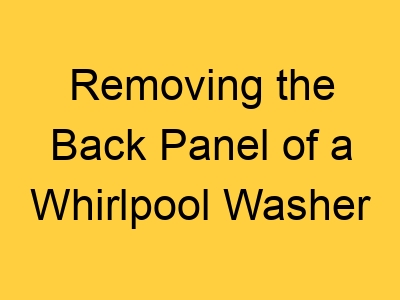Quck answer
To remove the back panel of a Whirlpool washer, follow these steps:
1. Unplug the washer from the power source for safety.
2. Locate the screws holding the back panel in place. They are usually located along the edges of the panel.
3. Use a screwdriver to remove these screws.
4. Once the screws are removed, carefully pull the back panel away from the washer. It may be helpful to have someone assist you in holding the panel as you remove it.
5. Set the panel aside in a safe location.
6. To reassemble the washer, simply reverse the steps and secure the back panel back in place with the screws.
Remember to always exercise caution when working with electrical appliances and consult the user manual for specific instructions related to your Whirlpool washer model.
If you need to perform repairs on your Whirlpool washer, you may need to remove the back panel. However, this requires some preparation, including removing the control console on the top of the unit.
Step 1
Before starting, unplug the washer and turn off the water lines. You can do this by turning the oval handles on the hoses near the wall clockwise.
Step 2
Locate the screws on either side of the washer console. These screws hold the panel with the control dials. Use a Phillips-head screwdriver to remove each screw.
Step 3
Slide the console towards the front of the machine until the tabs underneath clear the slots on the top of the cabinet. Then, lift it up and roll it open on its hinges.
Step 4
Disconnect the console from the washer. Press the tab on the plug and pull it out. You will see wires harnessed together connected to the washer.
Step 5
Remove the flat, wavy silver metal clips that connect the top of the washer cabinet to the rear panel. There will be one clip in the slots on each side, usually covered by the console. Pry the ends of the clips out from the top of the cabinet using a flat head screwdriver. This will loosen the tension so that the other end slides down and out of the tab on the back panel.
Step 6
Slide the ends of the clips out from the back panel.
Step 7
Open the washer’s lid and tilt the cabinet towards you, separating it from the back panel.
FAQ
1. How do I remove the back panel of my Whirlpool washer?
To remove the back panel of your Whirlpool washer, you will need a few tools such as a screwdriver and a socket wrench. Start by unplugging the washer from the power source. Then, locate the screws holding the back panel in place. These screws are usually found along the edges of the panel. Use a screwdriver to remove the screws. Once the screws are removed, gently pull the back panel away from the washer, being careful not to damage any wires or components. The panel should easily come off, allowing you access to the internal parts of the washer.
2. Can I remove the back panel of my Whirlpool washer to clean it?
Yes, you can remove the back panel of your Whirlpool washer to clean it. However, it is important to note that the back panel is not typically removable for routine cleaning. The back panel is designed to protect the internal components of the washer, and it is not necessary to clean it frequently. If you notice any debris or buildup on the back panel, you can use a soft cloth or a vacuum cleaner with a brush attachment to gently remove it. Avoid using water or cleaning solutions on the back panel, as this can damage the electrical components of the washer.
3. Do I need to remove the back panel of my Whirlpool washer to replace a part?
In most cases, you do not need to remove the back panel of your Whirlpool washer to replace a part. Many of the components can be accessed from the front or top of the washer. However, there are some instances where removing the back panel may be necessary, especially if you need to access the motor or the wiring. If you are unsure whether you need to remove the back panel to replace a specific part, consult the washer’s manual or contact a professional technician for assistance. They will be able to guide you through the necessary steps to safely replace the part.

